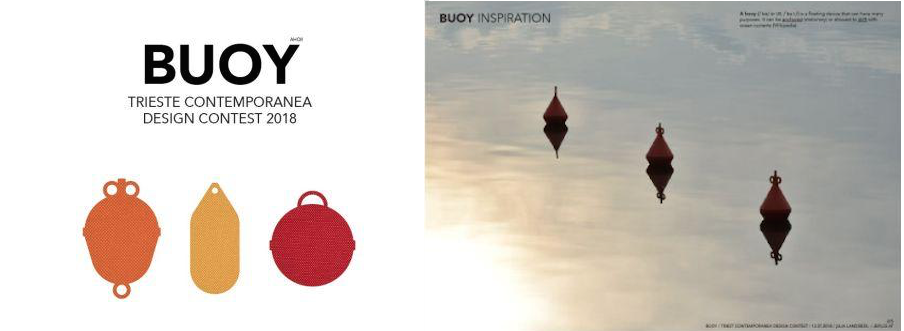more on design contest results
press release

Julia Landsiedl, Buoy, 2018, Gillo Dorfles Award 2018
The Austrian designer JULIA LANDSIEDL wins the GILLO DORFLES AWARD. Both the TRIESTE AWARD and the BEBA AWARD go to the young Turkey architect MERIÇ ARSLANOĞLU. MILAN RANKOVIĆ from Serbia takes home the C.E.I. AWARD. A great 2018 edition – the 13th this one – of the biennial International Design Contest Trieste Contemporanea awards the best European projects fitting the 2018 challenging theme HARBOUR FOR CULTURES.
The award ceremony is awaited on Saturday, the 8th of September 2018, in conjunction with the opening of the exhibition of finalist works selected by the Jury.
The Trieste Contemporanea Committee is pleased to announce the results of the thirteenth edition of the International Design Contest founded by Gillo Dorfles in 1995 with the aim of showcasing the most original design offerings from the countries of Central Eastern Europe.
5 projects – among them 3 winners, total prize money of € 9000 – have just been selected by the Trieste Contemporanea international jury as the best proposals this year submitted in view of meeting the contest’s request of giving a contribution in conceiving a harbour for cultures.
The 2018 edition of the contest has been based in fact on the 2017-2019 ongoing process-project HARBOUR FOR CULTURES promoted by Trieste Contemporanea through several actions, debates, events and exhibitions – of which one part is now on display at the Haus der Architektur in Graz. The project draws inspiration from the real case history of how to convert and reuse the area of Porto Vecchio (old port) of Trieste. This practical topic of rethinking for new uses the widest waterfront currently available in Europe, after having remained in a state of decay for decades, is now the issue on which international professionals and the whole city of Trieste are called to have a vision. But, as the promoters of the H/C project believe, it could be also a more ideal actual point from which we could look forward and imagine how new places and the future of cities may be tomorrow, in a society beyond geographical and mental borders where people freely exchange their cultures and benefits of art and culture are earned by the many.
While enrolling to the 2018 H/C design contest the candidates have taken part in this utopia-incubator for imagining a “new port” and have re-interpreted from this different perspective the usual functions of a port (issues of goods, insurance and profit) and its interim state between arriving, belonging and leaving.
In the main session of the competition, answering to the question “Which object would you imagine to find in / bring to / take from a harbour for cultures?”, participants were asked to conceive an original and innovative item of contemporary design. From this session, 22 candidates from 11 countries, comes the winner of the Dorfles Prize, the Austrian designer Julia Landsiedl, which presents a project inspired by buoys located in the gulf of Trieste: a new object in recycled polyester and in form of big “buoys”, inviting people to take a seat, rest and chat, or smaller ones, as portable pillows, which are useful on any other trip. A Special Mention has also been given to the project “Sal_ary”, presented by the Croatian designer Ines Vlahović: a salt bag/keeper sewed of sustainable and environmental friendly material and inspired to ancient Rome, times in which salt was precious and also the one from Adriatic was used as payment (salary).
Three Awards and a Special Mention arrive from the special session of the competition dedicated to the Port of Trieste, 30 candidates from 9 countries.
The set up TRIESTE Award has been assigned for his project “CON-TAG #” to the Turkey architect Meriç Arslanoğlu, 26, together also with the BEBA Award for the youngest participant selected. The young contestant envisages a system of air pumps + ballons that is responsive to digital data flow from mainstream social media in view of creating a floating piazza in the Porto Vecchio (in this case working with hashtags).
The CEI Award for the best design from one of the non-EU CEI countries has been assigned to Milan Ranković, a Serbian designer that presented the project “S-case”, a portable solar suitcase that uses solar panels to produce electric energy and that can also be used for cooking. Finally, the Turkey group formed by Cansu Dinç, Beyzanur Meriç, Sunay Paşaoğlu, Ebranur Yýlmaz, have had a Special Mention for their project “threshang”, a large map-drawing of imaginary new functions in all the area of Porto Vecchio, “beyond” the railway-roadway wall here existent and “on” the general ambiguity of walls as depicted by American writer Ursula K. Le Guin in her 1974 science fiction novel “Dispossessed”.
All projects were presented in an exhibition, opening in Trieste on the 8th of September 2018, and the award ceremony was held in conjunction.
The contest has been organised by the Trieste Contemporanea Committee in the frame of “Harbour for Cultures” 2018 activities | under the auspices of the Central European Initiative and of the BEBA Foundation, Venice | with the patronage of the Italian Ministry of Cultural Heritage and Activities and the Trieste Town Council | with the funding of the Autonomous Friuli Venezia Giulia Regional Council | with the collaboration of the MAO–Museum of Architecture and Design, Ljubljana | and of Culturelink Network/IRMO, Croatia; ICA–Institute for Contemporary Art, Zagreb; KCB–Cultural Centre Belgrade; L’Officina, Trieste; Studio Tommaseo, Trieste | together with partners of the Continental Breakfast network.
read the announcement
the final exhibition
read the catalogue
https://www.triestecontemporanea.it/HC_2018/